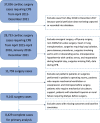Arterial Hyperoxemia During Cardiopulmonary Bypass Was Not Associated With Worse Postoperative Pulmonary Function: A Retrospective Cohort Study
- PMID: 37733624
- PMCID: PMC10994185
- DOI: 10.1213/ANE.0000000000006627
Arterial Hyperoxemia During Cardiopulmonary Bypass Was Not Associated With Worse Postoperative Pulmonary Function: A Retrospective Cohort Study
Abstract
Background: Arterial hyperoxemia may cause end-organ damage secondary to the increased formation of free oxygen radicals. The clinical evidence on postoperative lung toxicity from arterial hyperoxemia during cardiopulmonary bypass (CPB) is scarce, and the effect of arterial partial pressure of oxygen (Pa o2 ) during cardiac surgery on lung injury has been underinvestigated. Thus, we aimed to examine the relationship between Pa o2 during CPB and postoperative lung injury. Secondarily, we examined the relationship between Pa o2 and global (lactate), and regional tissue malperfusion (acute kidney injury). We further explored the association with regional tissue malperfusion by examining markers of cardiac (troponin) and liver injury (bilirubin).
Methods: This was a retrospective cohort study including patients who underwent elective cardiac surgeries (coronary artery bypass, valve, aortic, or combined) requiring CPB between April 2015 and December 2021 at a large quaternary medical center. The primary outcome was postoperative lung function defined as the ratio of Pa o2 to fractional inspired oxygen concentration (F io2 ); P/F ratio 6 hours following surgery or before extubation. The association between CPB in-line sample monitor Pa o2 and primary, secondary, and exploratory outcomes was evaluated using linear or logistic regression models adjusting for available baseline confounders.
Results: A total of 9141 patients met inclusion and exclusion criteria, and 8429 (92.2%) patients had complete baseline variables available and were included in the analysis. The mean age of the sample was 64 (SD = 13), and 68% were men (n = 6208). The time-weighted average (TWA) of in-line sample monitor Pa o2 during CPB was weakly positively associated with the postoperative P/F ratio. With a 100-unit increase in Pa o2 , the estimated increase in postoperative P/F ratio was 4.61 (95% CI, 0.71-8.50; P = .02). Our secondary analysis showed no significant association between Pa o2 with peak lactate 6 hours post CPB (geometric mean ratio [GMR], 1.01; 98.3% CI, 0.98-1.03; P = .55), average lactate 6 hours post CPB (GMR, 1.00; 98.3% CI, 0.97-1.03; P = .93), or acute kidney injury by Kidney Disease Improving Global Outcomes (KDIGO) criteria (odds ratio, 0.91; 98.3% CI, 0.75-1.10; P = .23).
Conclusions: Our investigation found no clinically significant association between Pa o2 during CPB and postoperative lung function. Similarly, there was no association between Pa o2 during CPB and lactate levels, postoperative renal function, or other exploratory outcomes.
Copyright © 2023 The Author(s). Published by Wolters Kluwer Health, Inc. on behalf of the International Anesthesia Research Society.
Conflict of interest statement
The authors declare no conflicts of interest.
Figures
References
-
- Buechter DD. Free radicals and oxygen toxicity. Pharm Res. 1988;5:253–260. - PubMed
-
- Ellman PI, Alvis JS, Tache-Leon C, et al. . Hyperoxic ventilation exacerbates lung reperfusion injury. J Thorac Cardiovasc Surg. 2005;130:1440. - PubMed
-
- Rodgers JL, Iyer D, Rodgers LE, Vanthenapalli S, Panguluri SK. Impact of hyperoxia on cardiac pathophysiology. J Cell Physiol. 2019;234:12595–12603. - PubMed
MeSH terms
Substances
LinkOut - more resources
Full Text Sources
Research Materials
Miscellaneous


